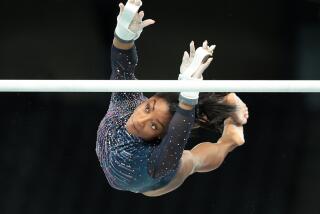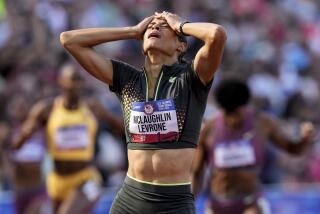It’s a Leap Year of Sorts : USC Triple Jumpers Brown and Bates Looking to Other Events in Bid to Make Olympic Team
Wendy Brown and Yvette Bates, USC’s B & B entry, have a class act in track and field, but seemingly have no place on the world stage.
Triple jumping is their specialty, but they’re limited to domestic competition because the relatively new event for women isn’t recognized by the International Amateur Athletic Federation, nor is it included in the Olympic program.
So Brown and Bates, both versatile athletes, are exploring alternative means of getting to Seoul, South Korea, for the Olympic Games in September.
Brown has become a heptathlete, while Bates is trying to improve enough in the long jump to make the U.S. team.
Those long-range plans will be put aside today when they will compete in multi events in the combined men’s and women’s dual track meet with UCLA at the Coliseum.
Brown realized that triple jumping was a dead-end internationally after she won the event in The Athletics Congress meet in 1986 with a wind-aided mark of 45 feet 2 inches, best ever at the time under any conditions.
“I had jumped farther than any other woman, and I wasn’t going anywhere,” Brown recalled. “I wasn’t even going to Russia for the Goodwill Games.
“That was the turning point . . . I pretty much gave the triple jump up. I’ve been competing in it, but not concentrating on it. I don’t even practice it. It has been all heptathlon. I just do it now to get points for the team.”
She will be trying to get them today while competing in the triple, long and high jumps, javelin, shotput and 100-meter hurdles.
“That’s a heptathlon in just one day,” she said.
UCLA’s Gail Devers will be just as active. She is entered in the 100, 200, 100-meter hurdles and long jump and will run a leg on the 400- and 1,600-meter relay teams.
Brown has only been a heptathlete for 14 months, and her personal best is 5,896 points. Her coach, Mike Bailey, reasons that Brown will need to score in the 6,300-point range to make the Olympic team.
Jackie Joyner-Kersee, the world record-holder, is, of course, a cinch to go Seoul barring injury. Jane Frederick, a veteran competitor, should place second in the trials, so that leaves only one spot.
Cindy Greiner, who has scored 6,275 points; Cathey Tyree, Sheila Tarr and, possibly, Jodi Anderson will most likely be Brown’s primary opposition.
“Cindy’s score is reachable by a few of us,” Brown said. “I think there will be some surprises.”
A raw talent who didn’t know the proper procedure in the shotput ring a year ago, Brown has improved, from 36 feet to 44-7, worth about 160 points in the heptathlon.
Brown, who has also played basketball at USC, reasons that if she trains hard enough, she’ll make the Olympic team. But she won’t be devastated if she doesn’t.
“I’m still young (22),” Brown said, “and when 1992 comes around I’ll be Jackie’s age (26).”
Brown and Bates are teammates now, but they were adversaries while growing up in the Bay Area. When Brown won the triple, long and high jump in the state meet in 1984 while competing for Woodside High School in Atherton, Calif., Bates, from Berkeley High, was second in the triple jump and third in the long jump.
Bates has improved to the extent that she’s a two-time National Collegiate Athletic Assn. indoor champion in the triple jump with best indoor and outdoor marks of 45-3 and 44-7 1/2, respectively. China’s Li Huirong has a world best mark of 46-0 3/4.
Bates is philosophical concerning the triple jump as a non-Olympic event, blaming athletes to a degree for not petitioning to include it.
Instead, she’ll be trying to make the team as a long jumper. It won’t be easy as Joyner-Kersee is the co-world record-holder at 24-5 1/2, Carol Lewis has a best mark of 23-1 3/4 and Jennifer Innis, Sheila Echols and Devers have all jumped in the 22-foot range. Bates’ best competitive mark is 21-0 3/4.
“I still think (the Olympic team) is open to any individual,” Bates said. “Those who have jumped in the 22-foot range aren’t 22-foot jumpers because they’re averaging in the 21-foot area. So there’s a chance.”
Bates, 22, says she has already had five jumps of more than 21 feet in practice without supervision. Now she has to put it all together in competition.
“She is always better in a meet than she is in competition,” Bailey said. “You can never count her out.”
Track Notes
Women’s field events begin at 10 a.m. today with the first running event at 1:30 p.m. Men’s field events start at 12:30 p.m. with the 400-meter relay at 2 the first race on the track. . . . The UCLA men’s team, defending NCAA champion, is heavily favored. . . . “It’s a difficult meet for us because we’re not a complete team,” USC Coach Ernie Bullard said. “There is not a better dual meet team put together in the 14 scholarship era than the one UCLA has now.” . . . However, there will be some competitive races in the middle distances and hurdles along with some field events. UCLA’s men’s and women’s teams are unbeaten in dual meet competition, both with 8-0 records. USC has concentrated on invitational and relay meets in recent years because of NCAA-imposed scholarship restrictions.
UCLA’s men have beaten USC nine straight years. However, USC still has a 38-16 series lead. The Trojans beat the Bruins 33 straight times from 1934 through 1965. . . . Since Bob Larsen became coach in 1985, UCLA has won 35 straight dual meets. . . . The women’s series is even at two wins apiece. The Trojans have won the past two years by identical scores of 69-67. UCLA women’s Coach Bob Kersee on Gail Devers’ busy schedule today: “She’ll run until we get 70 points. I don’t even trust 69.”
More to Read
Go beyond the scoreboard
Get the latest on L.A.'s teams in the daily Sports Report newsletter.
You may occasionally receive promotional content from the Los Angeles Times.






